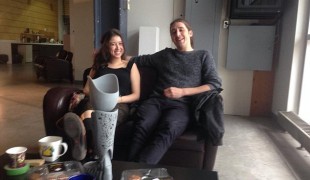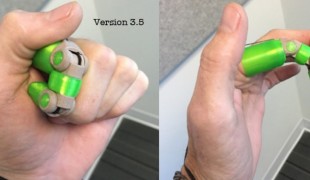- 9173
- 523
- 15
- 15
- 2
- Help Ukraine
About the solution
Marie-t (named after Swedish ballet dancer Marie Taglioni) consists of a prosthetic leg is made from a 3D printing socket, foam-injected rational moulded foot, carbon fibre, stainless steel toe and rubber grip toe (to help provide the dancer with balance and momentum during rotations).
What’s innovative about this gadget is that, unlike traditional artificial limbs, which are designed to mimic the human body, it enables amputee ballet dancers to enhance their performance.
The designer got inspired to build this device after reading about a dancer who had lost her legs. “I once saw a report that a girl who loves to dance but lost her legs in the Wenchuan earthquake. She lost her chance to dance again. But if she lost her legs and had this prosthesis, she might have the opportunity to re-achieve her dreams. The current design is paying more and more attention to some special groups, to their spiritual life and to their dreams throughout their lives. This kind of design is more and more user-friendly design, I believe there will be more similar designs in the future, paying attention to details”, he noted.
Marie-T allows amputees to dance on pointe throughout a performance, encouraging dancers to create a new choreography that has never been executed by traditional ballerinas. “I wanted to explore what would happen if you could allow a person to perform on pointe 100 per cent of the time,” said An, who developed Marie-T over the course of four months. “How would ballet change? I wanted to create a tool for someone to take and let their imagination define the capabilities of the product”, Jae-Hyun said.
While researching, the inventor realised that a weak ankle can twist and cause a ballerina in pointe position to wobble. With this in mind, she designed a strong and stable ankle area that helps the ballerina stay in balance. The ankle connects to a slightly curved carbon-fibre limb which helps absorb the shock from the impact of the ballet dancer stepping forward. The limb is topped by a 3D-printed socket with steel round head screws. Ill-fitting prosthetic limbs can cause blisters and rashes on dancers. The design also got this covered, as Marie-T’s prosthetic pieces can also be swapped in the case of resizing or replacing due to being worn down.
Jae-Hyun wants to keep developing his project by teaming up with an amputee dancer who shares his innovative vision for this new ballet genre.
Adapted from: https://bit.ly/32N7mwD
https://bit.ly/2Y4iqli
https://bit.ly/2LAJ5oa
More info: https://bit.ly/2Swcd04
这些解决方案不应包括使用药物,化学品或生物制品(包括食品);创伤性设备;冒犯性的,商业或内在危险的内容。该解决方案未经医学验证。请谨慎进行!如果您有任何疑问,请咨询健康专家。
DISCLAIMER: This story was written by someone who is not the author of the solution, therefore please be advised that, although it was written with the utmost respect for the innovation and the innovator, there can be some incorrect statements. If you find any errors please contact the patient Innovation team via info@patient-innovation.com
-
-
367
-
0
-
4222

Custom 3D printed prosthetics
WALKING: Walking
Limb Amputation
Limb Deformity
3d Printed
Prosthesis
Walking Aid (wheelchair/walker/crutches)
Restoring mobility
Replacing lost limbs
Promoting self-management
Promoting inclusivity and social integration
Enhancing Mental Health
Maintaining Balance and Mobility
Neurology
Orthopedics
Rheumatology
Canada
-
-
-
465
-
0
-
5568

Amputee develops 3D printing finger for himself
-
-
-
576
-
0
-
10320

Double amputee creates prosthesis for snowboarding and dancing
WALKING WITH A WALKING AID: Walking with a walking aid
Snowboarding
Dancing
Limb Amputation
Meningitis
Bacterial Infection
Prosthesis
Assistive Daily Life Device (to help ADL)
Difficulty walking or moving
Gait abnormalities (e.g., walking difficulties, unsteady gait)
Muscle weakness
Stiffness or rigidity (difficulty moving)
Limited range of motion
Recurrent fevers
Difficulty standing from a seated position
Difficulty fighting off infections
Changes in appetite or weight
Swelling or inflammation
Restoring mobility
Replacing lost limbs
Promoting inclusivity and social integration
General and Family Medicine
Infectious Diseases
Neurology
Orthopedics
United States
-
 zh
zh
luciham20 • Wed, 07/24/2019 - 13:42